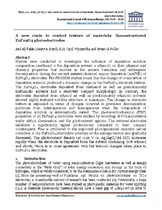| dc.contributor.author | Tahir, Asif Ali | |
| dc.contributor.author | Burch, Henry A. | |
| dc.contributor.author | Wijayantha, K.G. Upul | |
| dc.contributor.author | Pollet, Bruno G. | |
| dc.date.accessioned | 2018-02-16T13:22:40Z | |
| dc.date.available | 2018-02-16T13:22:40Z | |
| dc.date.issued | 2013 | |
| dc.identifier.citation | Tahir, A.A. et al. (2013). A new route to control texture of materials: Nanostructured ZnFe2O4
photoelectrodes.
International Journal of Hydrogen Energy, 38: 4315 – 4323 | |
| dc.identifier.issn | 0360-3199 | |
| dc.identifier.uri | http://hdl.handle.net/10566/3512 | |
| dc.identifier.uri | http://dx.doi.org/10.1016/j.ijhydene.2013.01.130 | |
| dc.description.abstract | Studies were conducted to investigate the influence of deposition solution composition (methanol ≤ the deposition solvent ≤ ethanol) on their physical and chemical properties that matters in the aerosol formation and subsequent decomposition during the aerosol assisted chemical vapour deposition (AACVD) of ZnFe2O4 electrodes. The FEGSEM studies found that the change of composition of deposition solution produced a dramatic change in the ZnFe2O4 electrode texture. The ZnFe2O4 electrodes deposited from methanol as well as predominately methanolic solvents had a relatively compact morphology. In contrast, the electrodes deposited from ethanol as well as predominately ethanolic solvents showed highly textured rod-like structure at nanoscale. The change in electrode texture is explained in terms of changes occurred in precursor decomposition pathways from heterogeneous and homogeneous when the composition of deposition solution is systematically varied. The photoelectrochemical (PEC) properties of all ZnFe2O4 electrodes were studied by recording JeV characteristics under AM1.5 illumination and the photocurrent spectra. The textured electrodes exhibited a significantly higher photocurrent compared to their compact counterparts. This is attributed to the improved photogenerated minority carrier collection at the ZnFe2O4/electrolyte interface as the average feature size gradually decreased. The photocurrent density (at 0.25 V vs. Ag/AgCl/3M KCl) increases rapidly when the electrode is deposited from the solvent containing 60% ethanol and above, which is in close agreement with the textural changes taken place in ZnFe2O4 electrodes. | |
| dc.rights | This is the author-version of the article published online at: http://dx.doi.org/10.1016/j.ijhydene.2013.01.130 | |
| dc.title | A new route to control texture of materials: Nanostructured ZnFe2O4 photoelectrodes | |
| dc.privacy.showsubmitter | FALSE | |
| dc.status.ispeerreviewed | TRUE | |
| dc.description.accreditation | Web of Science | |

